Note: This text course is an edited transcript of a live webinar. The following supplemental materials are available for download: slides handout, O-continuum, PRPearson.
Learning Objectives
- Participants will be able to define "Pillar of Community" marketing.
- Participants will be able to explain why "Pillar of Community" marketing is important.
- Participants will be able to identify 4 to 5 "Pillar of Community" marketing tactics and describe how to implement them.
Introduction
Brian Taylor: The title of my presentation today is How to Become a Pillar in Your Community: Knowledge-Based Marketing Tactics. Today we will talk about attracting customers and differentiating your business based on knowledge-based marketing tactics.
In today’s agenda, we will start by talking about the new consumer, or baby boomer, or healthy ager. We will talk about how new consumers are different from traditional consumers we have seen in our practices over the years. We will talk about how these new consumers hit the marketplace looking for hearing care services, and if these patients have the ability to transform our practice.
Demographics
Imagine you are in a community of 10,000 people. In your community, which we call your footprint, how many people are in the market for your services? Our target market is typically people over the age of 65, because they are more likely to have a hearing loss. We also know that that population is aging. There are more people who are turning 65 every year than ever in human history. We also know that people are living longer and healthier lives. For us, that could be beneficial, because a greater segment of the market that might be attracted to our services. What does this mean to our practice, and can it transform our practice?
Let’s look at 100 individuals within a village of 10,000 people. If you look at demographic information in the United States, you can make some strong inferences about who might be attracted to your practice. In a sample of 100 individuals, approximately 12 of those individuals are going to be in our target market of 65 years or older. Of those 12 individuals, 8 of the 12 will have some hearing loss. We know that only one out of eight will likely come to your office, purchase hearing aids, and be a full-time hearing aid user. The exciting thing from a business perspective is that we know the population is growing with longevity. What does that mean to our practices?
We can make projections about how many people will be turning 65 in 10 years and how many people might be in the market for hearing care and use amplification. In 10 years in our village of 10,000 people, we can sample another 100 people. Twenty of those individuals will be 65 or older. That is a marked increase in just a 10-year period of time. We went from 14 out of 100 to 20 out of 100, which we can accurately assume may be in the market for our services. Then 14 of those 20 are likely to have some degree of hearing loss. Again, we went from about 10 to 14, which is a marked increase.
If things stay the same as far as market penetration and full-time use rate of hearing aids for existing customers, we go from 1 to 2 of those patients wearing hearing aids on a full-time basis. It might seem like we are doubling the numbers, but we are doubling a very small number. This is a paltry increase in the number of users when we maintain the status quo. Even though more people over the next decade are going to be in the market for our services, if we do not change some of the things we do to attract and retain patients, we will not make much of a dent in the productivity of our practices.
Key Questions
Here are the key questions I want to discuss: What is the current landscape?; How do we attract and keep the new customer?; What is Pillar of Community marketing?; What does the implementation of Pillar of Community marketing look like?
We will look briefly at the current landscape of hearing care and go more in depth with the demographic information. We will talk about how we can attract and keep new consumers. We will talk about this concept I call Pillar of Community Marketing and what that means primarily to an independent practice. Lastly, we will talk about the implementation of this marketing strategy.
Current Landscape
First, competition does not make it any easier for us. We all know about the rise of big-box retail and chains, or corporate audiology as some people call it. Although we cannot be certain, we know that Internet distribution of hearing aids and personal sound amplification products are on the rise. There are more of those available, but we do not know how much business that might be taking away from us now and into the future.
Old Consumers and New Consumers
We also know that in the face of all these things, much of how we market and advertise our practice is price driven and revolves around the distribution of a product, the hearing aid. Baby boomers, or so-called new consumers, approach the market in a much different way than previous generations. They have different needs and wants out of the market. They do more homework before they make an appointment. We have to factor those things in when we are dealing with these new consumers.
Figure 1 summarizes some of the key differences between old consumers and new consumers. You can think of the points on the left as that of an 85- or 90-year-old patient who is a bit more passive. They might be more price-conscious. They might be more willing to trust the marketing message that is in front of them. On the other hand, new consumers, which seem to be quickly supplanting the old consumer behavior regardless of age, do a lot more shopping and are much more likely to seek a meaningful experience with their interaction in your clinic. They want to be more actively participate in the decision-making process. Rather than looking for the lowest price, they look at what is the best value. This should be a main consideration when we are trying to attract new patients and retain patients in our practice.
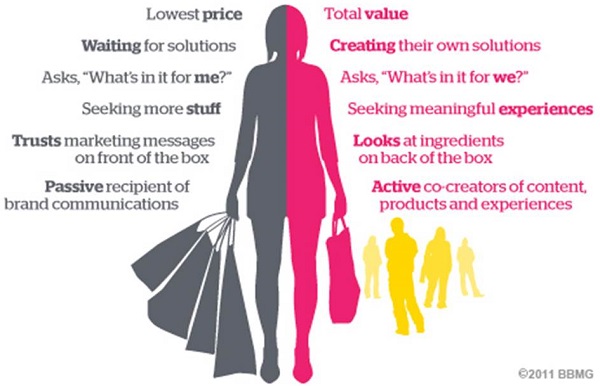
Figure 1. Comparison of the old consumer (left, gray) and the new consumer (right, pink).
Loyalty Loop
Perhaps another way to look at the way new consumers approach the market is by the Loyalty Loop (Figure 2). The Loyalty Loop has six stages of the buying process: consider, evaluate, buy, enjoy, advocate, and bond. There is a wide gap between consider, evaluate, and buy. Some of the science behind this, which comes from the Harvard Business Review, suggests that customers take more time during the consideration and the evaluation process before they make a decision. Once they do make a purchase, they often want to maintain a relationship with the provider and the brand after that buying transaction has occurred. It is important that we stay in the loop with our customers along these six stages. It does not end with the transaction. In many ways, the transaction is the beginning of the relationship.
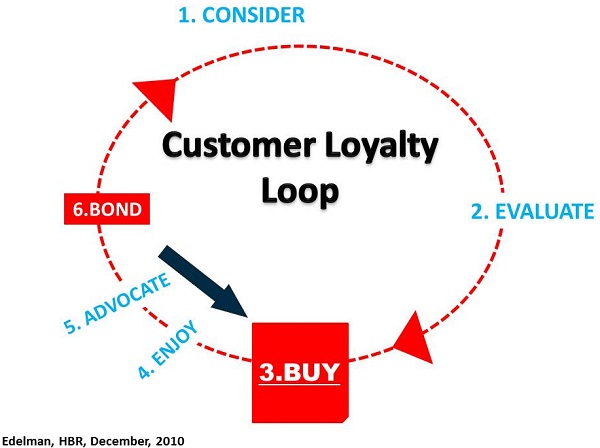
Figure 2. Customer loyalty loop.
Customer Acquisition
Another line of thinking that I want to explore comes from a book called Absolute Value, by Simonson & Rosen (2014). They assert that existing customers have more influence on future customers. There are three ways that people know about and experience your practice. There are the prior experiences, beliefs, and ideas of the existing customer. There is information from marketers, advertising and direct mail - the traditional forms of marketing. Then people learn that you exist from word-of-mouth.
One decade ago in 2004, we acquired customers in one of three ways: the customer themselves, their prior experiences with you and your practice, marketing information they receive through various efforts, and word-of-mouth from other people. The marketing information, or traditional advertising, was the primary means by which customers were acquired.
What has changed in the last 10 years? Word-of-mouth is becoming a much more powerful way for other potential customers to know that you exist and deliver a high quality of care. This is simply because of ease of access through the Internet and social media. When it comes to customer acquisition. In today's marketplace, prior experiences of customers and your marketing strategy are still important. However, we are finding that the role of other people through word-of-mouth and social media is becoming the primary way in which customers are influenced during the consideration and purchasing processes.
Simonson & Rosen (2014) developed something called O-continuum (opinion-continuum), which is how independent or dependent the role of other people's opinions is on your business (Figure 3). They found that there are certain sectors of the economy that are very O-independent, and at the same time, there are other sectors of the economy that are very O-dependent. Where does your practice fall on the O-continuum?
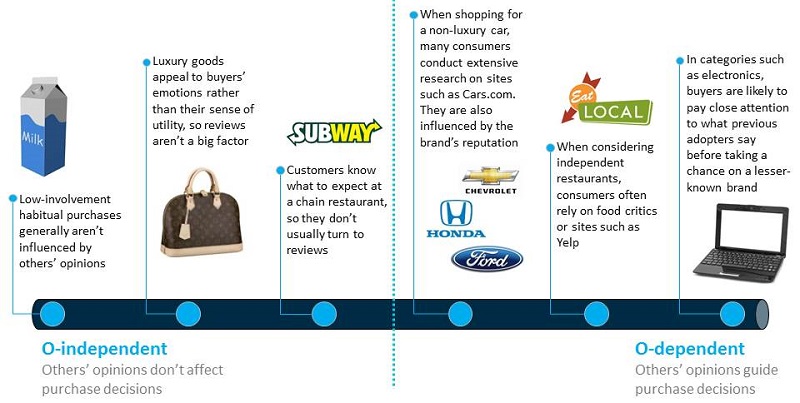
Figure 3. The O-continuum, from O-independent (left) to O-dependent (right).
O-Independent
According to the authors, commodity purchases that you find in a grocery store and gasoline are very O-independent types of goods and services. We buy them out of necessity or habit. We do not talk to a lot of other people before we buy a gallon of milk or gasoline. We know that the quality is going to be even no matter where you get it, and these items are often at a relatively low price point.
An example of O-independent goods and services at the high end of the price spectrum would be luxury items like designer handbags, designer clothes, jewelry, or luxury automobiles. Because the brand has such high regard and high esteem throughout the marketplace, people do not do a lot of talking and exchanging opinions. The brand speaks for itself based on tradition and quality over many decades.
We also have things like chain restaurants. When a brand is known, there is not a lot of exchange of ideas amongst individuals. Most people know what that brand signifies. If you are in new town and want to eat out, you might be more likely to go to a chain with which you are somewhat familiar to ensure that you will get a good meal. You are more likely to forego the independent restaurant because you are unsure of what the menu offers, you have a limited amount of money to spend and a limited amount of time. You go with the brand, because you know what you will get.
O-Dependent
On the O-dependent side of the scale (Figure 3), others’ opinions guide purchase decisions more often. Some of these goods and services that fall toward the middle of the O-continuum are non-luxury automobiles, such as Honda, Ford, Chevy, or Nissan. You know what you are getting, but you might shop around a bit. You may use the Internet to help research and come to a decision.
Something that is more O dependent would be local, independent, or family-run restaurants. The food may be of the utmost quality, but you would not know until you experienced it or asked other people's opinions. Now due to social media and Internet services like yelp.com, those opinions are amplified at a phenomenal pace because all the opinions are posted in one place. Rather than going to the local restaurant’s website, you could go to yelp.com and read reviews before you make your decision. Those 1 to 5 star reviews are incredibly powerful and make a difference for independent entities.
Perhaps the most O-dependent sector of the economy would be consumer electronic devices. There are a lot of choices. People know what they want to spend and they do a considerable amount of homework and comparison-shopping before they make those decisions. They will talk to other people and read online reviews or forums.
So where does your practice fall on the O continuum? I do not have a right or wrong answer for where a practice might fall on the O continuum, but if you are on the O-dependent side, it simply means you need to spend a little bit more time making sure you have a presence in places where people do comparison shopping. There are companies now like Hearing Tracker, for example, that will help you archive and keep reviews in an orderly manner on your website or on someone else's website. It is a way to attract people to your page. Another nation-wide company is Review Buzz, and they allow customers to write reviews. They are attached to your presence search engines, and they have shown that people who use Review Buzz get a little more traffic on their website through the rating system.
The big picture is that with competition, you cannot coast on your reputation or past performance in this era of technology. It is imperative for all of us to look for new ways to add value to our business, to be unique, and look at new markets for services. Engaging with the community must be an ongoing effort in order to maintain top-of-mind presence. That necessitates the need for what I call Pillar of Community marketing.
Pillar of Community Marketing
Let’s go back to our village of 10,000 people. We all have a footprint where we are trying to attract a group of patients. The significant segment for the majority of us would be those who are 65 years and older people. Right now, only one in eight of those people come in to see us, get hearing aids, and use them on a semi-full-time basis. My goal is to get to seven out of those eight knowing that you exist and what you can offer them. Not all of those will wear hearing aids, but the big picture with Pillar of Community marketing is to engage seven in eight rather than one in eight of our target demographic.
Crack the Code
Some ways to crack that code and increase that number might be exerting more social pressure to get non-users to act. One way is to use positive methods to get people to have a hearing screening sooner rather than later. Another way is to use search engines and sites like Hearing Tracker that archive reviews of products and service so that we can take today's very happy and satisfied customers and use those testimonials to drive the success of future customers.
One important way to crack the code in any city with respect to hearing care would be to achieve what I call Pillar of Community status. Pillar of Community marketing means being at the top-of-mind in your community for all aspects of hearing care. It is your ability to foster relationships with three distinct groups within your footprint so that people are willing and able to act when they may think they have a need for a service or product that you offer. It goes beyond offering an amplification device; it is about engaging the entire community in the conversation of better hearing and better communication.
It is a long-term strategy designed to engage the entire community, influencers, and other professionals. That long-term strategy involves some traditional aspects of market planning, budgeting, and advertising. Rather than putting the hearing aid at the center of things, it puts your professionalism and ability to serve the community at the heart of your brand.
Three Distinct Groups
I talked about three distinct groups: community, primary care physicians and patients. The community is other business owners, other professionals, or other people delivering services to the community. Primary care physicians are the gatekeepers to healthcare. Their importance will only increase over time with some of the changes in healthcare and insurance reimbursement. Finally, we have existing patients, who are important for your word-of-mouth marketing efforts. You need to have a marketing strategy that engages all three groups in order to have a long-lasting, long-term relationship with them.
Developing your Brand Message
I want to talk briefly on how you develop a brand message, because it ties in to the Pillar of Community marketing. You should spend an ample amount of time developing your brand and your core brand message. One exercise is to sit down with the stakeholders in the practice, such as the owner, the front office staff, audiologists, technicians and the physician, if there is one. You brainstorm for what is unique about the services and the products that you offer to your community. This is not an easy question to answer.
Then you brainstorm what you want to be known for in your community. Every business has a reputation, good or bad, deliberate or not, and you want to spend some time thinking about what you want to be known for. It may take a few years to get that off the ground, but it is worth the effort. Lastly, look at what demands for services your community has. Is there a service you can offer that is not offered by someone else?
These are questions to address and fine-tune over a period of time. For example, from a brainstorming session, one practice determined that they wanted to be known for being patient-centered, service driven, going the extra mile, and having 30 years of clinical experience. Your brainstorming sessions will help you develop your brand story and message, which you can use as part of your marketing campaign in this Pillar of Community strategy. Once you have taken ample time to do that, you will have an idea of what your tagline and your messaging might be. The most important thing in this session is that your branding and messaging has to be authentic, emotional and something that everyone believes in.
Here is a link to download a brand personality worksheet. Cassie Johnson in the marketing department at Unitron put that together, but it is something I have seen work well to start the conversation and better articulate what your clinic stands for. Before you go too far down the tactical route, you should spend two to four weeks trying to formulate and articulate your brand story in the messaging. When you are nearly completely comfortable with it and have some alignment within your team, it is time to go discuss how you pull it off.
Pillar of Community Marketing Tactics
How do we take action around this strategy of Pillar of Community? First and foremost, traditional media still works. According to Call Source, direct-mail and newspaper are still overwhelmingly the top two attractors of prospects, followed by website and TV. Just because we have new technological strategies available does not mean some of the traditional tactics go by the wayside. They still can be very useful.
You want to supplement traditional media with five distinct tactics that should be part of a Pillar of Community marketing plan: captivating website, online reputation manager, relationship & medical marketing, an upstanding member of your community (PR), and social media; these all stand for CORUS. The main idea behind these tactics is to engage and create conversations with patients and other stakeholders within the community throughout their journey. It is not just about the patients; it is also about the other members of the community.
Captivating Website
There is no shortage of great websites, and according to Call Source, websites were the number three media to attract prospects. We cannot understate the importance of a captivating website. My definition of this is having video, front and center, which allows people to better know your practice and what you are offering. It should be brief, emotionally compelling content.
Figure 4 shows a website from the Lasik Eye Care world. The Gift of Sight video on their site is about 90 seconds. That is an important component to your website. You will notice there is a blog, which is another important component of a captivating website. It has connections to Facebook, Twitter, and YouTube at the top. Also notice the video testimonials on the right sidebar.
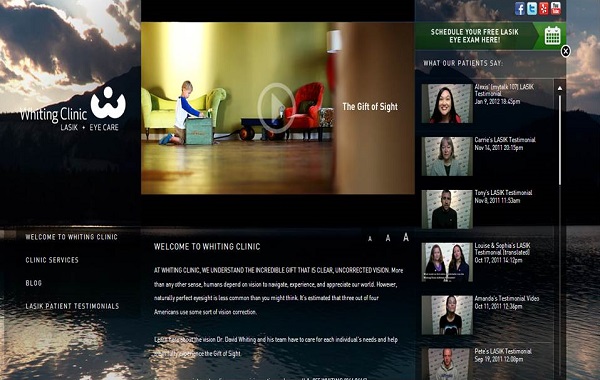
Figure 4. Example of a captivating website, with video, blog and patient testimonials.
Fortunately, these types of websites are relatively inexpensive, and there are number of experts that could help you add these elements to your existing website.
Online Reputation Manager
I have already mentioned the online reputation manager, Review Buzz, which is to encourage people to write reviews of your practice. If it is a favorable review with several stars, then it is likely to be tied to your name as it appears on search engines. Experts say that prospective customers are more likely to click on your website if there are positive reviews that stand out, even if it appears further down on page one. Review Buzz and others allow you to do this in a cost-effective, seamless way.
Figure 5 is another example of a good website. Patients are driven to this website and encouraged to write testimonials. When other people are shopping around, they are likely to read those positive testimonials. An online reputation manager would be an essential part of the Pillar of Community Marketing strategy.
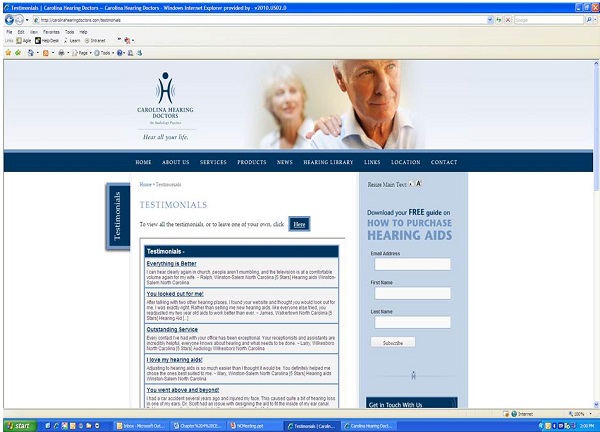
Figure 5. Website featuring testimonials.
Relationship and Medical Marketing
Other names for relationship and medical marketing would be disease state or comorbidity marketing. It is nothing more than building a trusting, systematic relationship with primary care physicians and other related medical specialties, using the best available clinical research showing the link between age-related hearing loss and other chronic medical conditions. There is an abundance of this information available today. While some of this is intuitive to us, now we have the science to back up the fact that people who have hearing loss are more likely to suffer the effects of early onset dementia. They are more likely to be depressed, feel socially isolated, and be expensive to take care of because they cannot hear the physician and the nurse during the interaction. However, the real opportunity rests in some of the changes to the medical establishment.
We are seeing the rise of accountable care organizations. Physicians are being incentivized and paid based on outcomes rather than the number of procedures. They are more likely to be practicing preventive medicine. We also see the rise of the quantifiable self-movement, where people can measure different bodily functions using technology like FitBit, so they are involved in the process earlier on. We are seeing some of the science behind age-related hearing loss and how that might be a public health crisis. We also know that primary care physicians outnumber audiologists and hearing instrument specialists combined at a 12 to 1 ratio. There are incredible opportunities to build relationships, as long as you convey the right message.
Frank Lin has provided a good summary of the science behind the consequences of age-related hearing loss and how it affects other conditions. You can find more information on his website, linresearch.org. What affects your hearing also impacts other areas in the brain, and ultimately accelerates declines in higher cognitive functions. Now we have the science to show that these all fit together.
Figure 6 lists seven articles from peer-reviewed medical literature showing a relationship between age-related hearing loss and other chronic conditions and comorbidities. If you wanted to build a strong relationship with physicians, a straightforward way would be to know the basics of the science behind these articles and be able to talk about it intelligently with any physician or nurse. If you want access to these articles, please email me. Unitron has developed Better Hearing is Better Living flyers also that you can use in the education process. These are available upon request.

Figure 6. Peer-reviewed literature linking age-related hearing loss to other comorbidities.
I have worked with Dr. Weinstein at the Graduate Center at the City University of New York to develop a toolkit for primary care and geriatric physicians. This is a 30 page PDF that you can use to educate primary care physicians about the value your profession brings to the community and to their patients. We are currently doing some studies now to show its effectiveness and document the need for it, but this is also available by request.
Upstanding Member of Community
The upstanding member of your community is a long-winded version of public relations (PR). PR is a way for you to work with other businesses that are similar to yours, such as optometry, primary care and chiropractic medicine. You can name some others that are aligned with the vision and mission of your practice to create educational awareness within your community.
Here are some examples of what I mean by PR. You could install a loop system in the local auditorium, church, or theater. You could organize a community picnic with better hearing as a theme or partner with an optometrist to do hearing and vision screenings. It is a great way to build relationships with similar medical specialties.
You can find a way to talk about new technology for hearing loss on local television. There are also opportunities to co-facilitate community educational seminars with other medical specialties. A good example of this would be to partner with diabetes educators. In most communities, patients diagnosed with Type II diabetes are encouraged or required to see a diabetes educator, and that person is responsible for overseeing changes in their day-to-day behaviors with respect to diet, exercise and overall health. The opportunity would be to offer a community seminar around diabetes and hearing loss. It is a way to get the message out through a different channel or in front of some different people. If you are interested in the specifics on this, please reach out to me, and I can give you some direction as to create that opportunity.
Social Media
The final tactic in the CORUS messaging is Social Media. Social media content has to be educational, easy to read, and entertaining to get people's attention. It has to be personalized by you. The way in which to deliver the message can be done through blogging, writing/posting articles or attaching other bloggers’ articles on your website or on your Facebook page. Content is typically distributed via Facebook, Twitter and your website. Content and how you deliver it are the two most important factors for social media.
Some other things to keep in mind are that patients and new consumers actively shop, socialize, engage and learn via these different distribution networks. Think of this as a supplement to basic word-of-mouth and communication with physicians, the community, and your existing patients. It is simply there to amplify your presence in front of these three primary groups. It is important that you pay attention to the content you post.
Anything you can do on a website, you can do on Facebook with ease for a fraction of the cost. The main point is to get people to like your Facebook page as a means to drive traffic there. Make sure that there is captivating information that is easy to find and use.
For example, set up a Twitter for yourself or your practice. The personality part of this is important. People go to a person, not necessarily a business. Let’s say you set up a Twitter around yourself as an audiologist. You are going to tell as many patients and other people in the community to follow you. Use whatever means necessary at your disposal to get people to follow you. This could be having the receptionist remind patients to follow you or other novel ideas. Expect this to take some time. Once you do that, start following other healthcare and hearing care specialists.
A good example of this is an innovative cardiologist whose name is Eric Topol. He has some creative opinions about the future of healthcare. He is someone you want to follow, because you can simply retweet his posts with a message from yourself. Spend about 5 to 10 minutes reviewing pages such as Mayo Clinic, Cleveland Clinic, National Institute on Deafness and Other Communication Disorders (NIDCD), and National Institutes of Health (NIH). Retweeting with a message adds a bit of your personality to the message that you are conveying to all of your followers. It is a great way to keep people part of the conversation and build a cohesive network of like-minded people.
Execution of Pillar of Community Strategy
In many ways, executing this strategy is nothing more than old-fashioned elbow grease and discipline, coupled with new, innovative tools. The universal challenge across the world, in my opinion, is attracting patients to our practices for all of the obvious reasons. People have a stigmatizing condition. We are trying to sell them, for lack of a better word, a service or device that they do not want to wear. They often have to pay for it out-of-pocket, and they do not want to admit that they have any kind of a handicapping condition. Practices that are disciplined about creating a plan and executing it are the ones that are most successful over the long term.
Steps
There are five steps to an execution of a plan. First and second are planning and budgeting. It is important to have some money available at your disposal for marketing. Generally, 10% of gross revenue should be dedicated to marketing. With respect to planning, make sure you take the time to develop a brand message and image, articulating what you want to be known for in your community, and put together a 12-month plan using some of the tactics we described. It is important that your calendar is scheduled with a handful of dates where you will directly advertise. Keep an idea of what your content and messaging is going to be with social media. Are you going to reach out to anyone in the community with respect the public relations? How many physicians are you going to contact and try to educate? All of those things need to be clearly planned out on a calendar.
Step three is to implement the plan. This is where things can often fall apart. Someone on your team has to be responsible for driving the plan. Step four is to have a measure of expectations and a measurement of return. How many patients are you getting for each tactic that you are using? This can be difficult to track with some of the newer media that is available, but the important point is that you are measuring the number of people that come in and how they found out about you. Take the time to ask your patients how they first learned about you or why they came, as it is an important way to measure and track your marketing efforts.
Step five is to modify and adjust your plan. You might find that there was a direct-mail piece that did not work, but you have it planned again for three months. You might want to adjust that plan. You have to be willing to constantly modify and adjust. The best way to do that is with your team. Look at where things are on a monthly basis and adjust as you see fit. Furthermore, it is difficult to do that unless you are measuring your effort and payoff.
Summary
When you are building your Pillar of Community status, it is important to embrace both sides of the hearing care equation. This needs to be intertwined with your brand image. There is a science to what we do. We treat patients. We have to respect that there is a degree of education and experience that goes along with clinical excellence, and that is treating patients accurately and ethically.
At the same time, we also have to embrace the fact that we are in an elective medical profession. People do not have to come and see us. They can spend their money on something else that is completely unrelated to hearing care. We have to not only treat our patients, but also serve our customers. Practices that embrace both sides of this equation with equal enthusiasm and due diligence will be most successful and stand out over the long term.
References
Simonson, I., & Rosen, E. (2014). Absolute value: What really influences customers in the age of (nearly) perfect information. New York, NY: Harper Collins Publishers.
Cite this Content as:
Taylor, B. (2015, February). Unitron Practice Development Series: how to become a pillar in your community - knowledge based marketing tactics. AudiologyOnline, Article 13254. Retrieved from https://www.audiologyonline.com.


